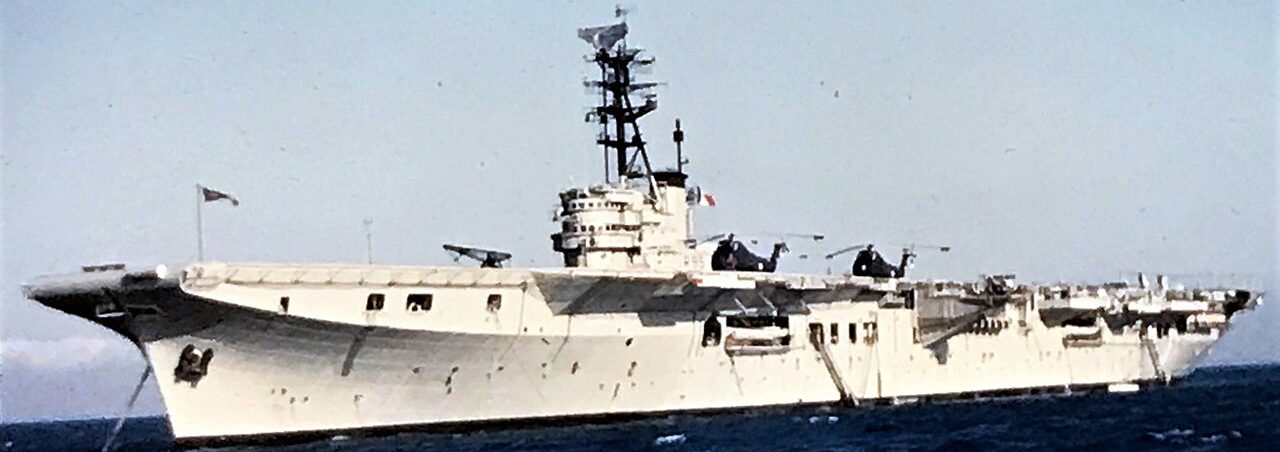
 Aircraft Carrier 1946-1974
Aircraft Carrier 1946-1974
The Aircraft Carrier Arromanches was the ex-HMS Colossus, lead ship of the famous 1942 light fleet aircraft carrier program. She was loaned in 1946 for five years to the Marine Nationale, made two tours of duties over Indochina until purchased in 1951, refitted. She served for two more tours and was back in the Mediterranean fleet, taking part in Operation musketeer in 1956 on Suez. Modernized in 1957-58 with an angled deck and mirror and new radars, she became a training carrier, for future airmen of the first French Carriers of the Clemenceau class. In 1959 she had a new air group and from 1962 became an assault carrier with HSS-1 helicopters, confirmed after her last 1968 she was modernization as pure helicopter carrier/ASW escort/Fast transport/TS. She was withdrawn in 1974. #frenchnavy #marinenationale #arromanches #colossusclass #aircraftcarrier #aeronavale
Introduction

Arromanches with a F6F-5 Hellcat landing circa 1953 in the Tonkin Gulf – U.S. Navy National Museum of Naval Aviation
Prior to WW2 France did not invested much into aircraft carriers, only converting a former cancelled battleship (Bearn) into what was a first, albeit slow fleet carrier, with an antiquated air park before receiving modern US Vought and French Loire dive bombers. It’s most valuable asset was Commandant Teste, a modern large seaplane carrier. Postwar, Bearn was sent to Toulon as depot ship, Cdt Test scrapped, and so the naval staff acquired three carriers to bolster its postwar fleet, notably to answer imperatives of the Indochina war and just filled the immediate needs of the Navy. These were FS Dixmude, the former escort carrier HMS Biter, and later in 1950-53 through MDAP two ex-Independence class, the former USS lafayette and Belleau Woods (as Bois Belleau) in service until 1960-63.
But the most praised acquisition, by far, was a former Colossus class light fleet carrier, the ex-HMS Colossus herself, head of the 1943 program light fleet carrier program. It was a large, capable platform on which the French Navy can build its first carrier group. She was acquired after conversion as angled carrier in August 1946, whereas work started in August the next year on the first new French design, PA 28, later cancelled for the two Lafayette.
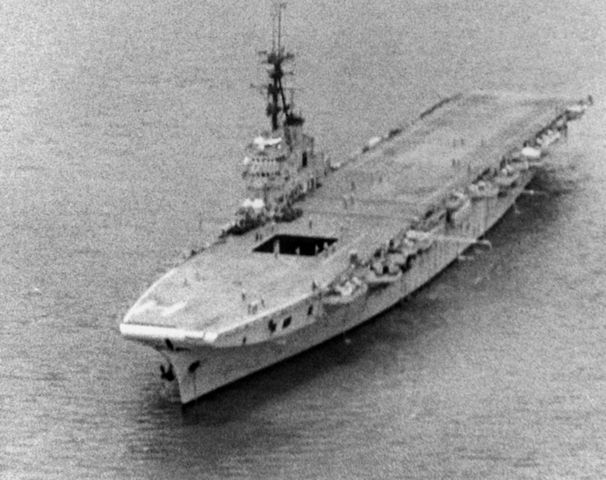 FS Arromanches was named after the artificial port and beaches associated with the Normandy D-Day landings and liberation of the country. She proved an invaluable asset during the Indochina war in 1950-54. Its flight of Corsair multiplied close ground support missions, notably using napalm for the first time. Later, Arromanches also soldiered in another colonial war, Algeria, but from 1962 she started to shift in an assault role and was geared to carry 30 helicopters. She was to be replaced by the PA 75 project helicopter carrier, which was cancelled, so she was stricken in 1974. In between she had been replaced i her main role by the new Clemenceau class whereas her assault role was taken by Jeanne d’Arc and later two tailored LHDs.
FS Arromanches was named after the artificial port and beaches associated with the Normandy D-Day landings and liberation of the country. She proved an invaluable asset during the Indochina war in 1950-54. Its flight of Corsair multiplied close ground support missions, notably using napalm for the first time. Later, Arromanches also soldiered in another colonial war, Algeria, but from 1962 she started to shift in an assault role and was geared to carry 30 helicopters. She was to be replaced by the PA 75 project helicopter carrier, which was cancelled, so she was stricken in 1974. In between she had been replaced i her main role by the new Clemenceau class whereas her assault role was taken by Jeanne d’Arc and later two tailored LHDs.
So in the end, France joined the cohort of happy users of the Colossus/Majestic/Centaur serie that saw little service in WW2 but soldiered on under many flags practically until the end of the cold war. Given that Arromanches was one of the earliest conversions, she was seen as obsolete however in 1960, unable to operate the new generation marine jets. But the Aeronavale stretched the use of carrier-based Corsairs like Argentina, while the type was long gone in the US.
Origin
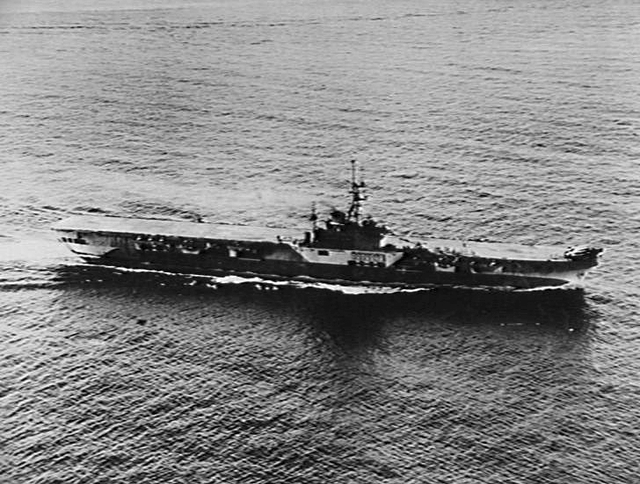
HMS Colossus off Shanghai in 1945
Arromanches was the former Vickers-Armstrong HMS Colossus, lead ship of the namesake class “1942 program light fleet aircraft carrier” program. Launched on September 30, 1943 she was commissioned in December 1944 in the Royal Navy and served a short while in WW2. She became in August flagship, Rear Admiral Cecil Harcourt, 11th Aircraft Carrier Squadron (Colossus, Venerable, Vengeance, and Glory), the second major BPF task force in the Pacific. First operation was a sortie to re-occupy Hong Kong on 19 August 1945). She repatriated Dutch POWs back to Colombo and by January 1946, trained off Naval Air Station Wingfield, South Africa, was drydocked refitted in Simonstown. By July, she left the Far East for home, and on 6 August, as an agreement was struck, she was transferred to France, on the basis of a five year loan.
She was recommissioned in Toulon renamed after the British landing zone “Gold” in homage to British contribution to the liberation, and in 1951, Arromanches was officially purchased as the loan expired. Already she was a veteran of Indo-China and would make two more deployments until 1954.
Design of the class
Hull and general design
No need to dive deep into it, as it was treated in detail on the Colossus article. Arromanches was not different from the original, she displaced 14,000 tonnes standard and up to 17,900 tonnes fully loaded. for an overall lenght of 693. 77 ft, 118. 11 ft in beam: 211 meters long, 25 meters hull beam at the waterline, 36 m overall at deck level. She had still in 1946 her straight deck, but it was modified later in her career as an angle deck. To compared crews, HMS Colossus had 854 crew, plus 222 for the Fleet Air Arm personnel but later under French flag, 703 crew (42 officers, 145 petty officers, 516 rating) but in peacetime. In wartime this went up to 844 (60 officers, 171 petty officers, and 613 sailors) so almost the same as in WW2.
For her flight deck and hangar, the first measured 210.3 meters long for 24.4m wide, but later ported to 36. It represented a useful surface of 5,131m². The hangar measured 135.6 meters long, 15.8 meters wide and 5.3 meters tall for a surface area of 2,142m² or a volume of 11,355m³. There were two lifts measuring 13.7 meters by 10.4 meters weighting 6.8t. There was also forward port side a slanted to axis catapult BH-III capable of launching a 6.4t aircraft at 122km/h. Aircraft fuel stowage aboard was 448,200 liters.
Originally her flight deck had eight arresting cables and two transverse crash barriers able to stop 6.8-ton planes landing at 60 knots or 40 residual knots for the barriers.
After her modernization in 1958 and her angled deck, she had ten arresting cables further apart, with six transverse aft of the rear elevator, four in front of the rear elevator, perpendicular to the axis of the oblique runway at 4° port.
Powerplant
No change here and during her whole carrer, she carried the same powerplant composed of two sets Parsons geared steam turbines coupled with four Admiralty 3-drum boilers (working at 400 psi or 2,76 MPa, 360 °C) for a total output of 40,000 hp and top speed of 25 knots (46 kph). Based on her fuel bunkerage she carried 3,196 tonnes, providing an endurance of 12,000 nautical miles or 22,000 km at 14 knots. We can imagine her machinery was pretty worn out in 1968, forcing her retirement.
Armament
Before entering French service she had a total of twenty-four Vickers-Armstrongs 2-pounder guns aboard, in six mounts and thirty-two Oerlikon 20 mm cannon. But it was soon modified to twenty-one Bofors 40 mm guns and four Ordnance QF 3-pounder Vickers guns.
The “pom pom” came into six quad 40mm/39 Mk VII mounts. The Oerlikons were 40mm/60 Mk III models.
The later Bofors were standard WW2 single mounts, but shielded. There was no consideration given to moout a more modern armament.
In 1958 indeed she was modrnized with her flight deck installed, but the armament was mostly removed.
With this 4°-angled flight deck her maximal beam at deck level went to 36 m and the catapult was removed, whereas she gained a DRBV-22A radar (see later).
Sensors
She did not kept her original British electronics suite.
-In 1947 she received the air only scanning 79B radar, and air/surface Type 277 and Type 281B radars. She also had a target indicator radar Type 293.
-In 1954 she still carried the Type 281B, 291B and 277 as well as the Type 293 for target indication, 79B air scan. But the YE Type ws installed and the French navigation DRBN-30 radar.
-In 1959 she only kept her YE radar but a DRBV-22 air/surface scanning radar and for navigation the new DRBV-31.
-In 1972 She only kept her DRBV-22 and DRBV-31, knowing she was in reserve since 1968.
Type 79B: Early-warning 70 kW radar Frq 43 MHz PRF 50s Bwt 70° Pwt 8-30 μs RA 90 nm (170 km; 100 mi) aircraft 20,000 ft, surrace 2–6 nm
Type 281B: Early-warning 350 kW radar FRQ 86–94 MHz PRF 50s Bwt 35° Pwt 2–3/15 μs RA 120 nm (220 km) 30,000 feet (9,100 m)
Six type 282 radars:(Bofors) UHF-band range, Yagi antennas, 150 kW.
Type 144 sonar: Trials in Kingfisher 1941, Retractable usable for Hedgehog type weapons.
Air Group

SNCASE Aquilon, operated at the time by the 11F and 16F Naval Squadrons. it was preceded in 1953 by the De Havilland Sea Vampire used by escadrille 57S. France tested also in 1951, and acquired the right to produce the Sea Venom Mk20 from 1952 at Marignane, operational from 1955 to 1966, used over Algeria and Bizerte, replaced the Hellcat but operated alongside the Corsair for close support.
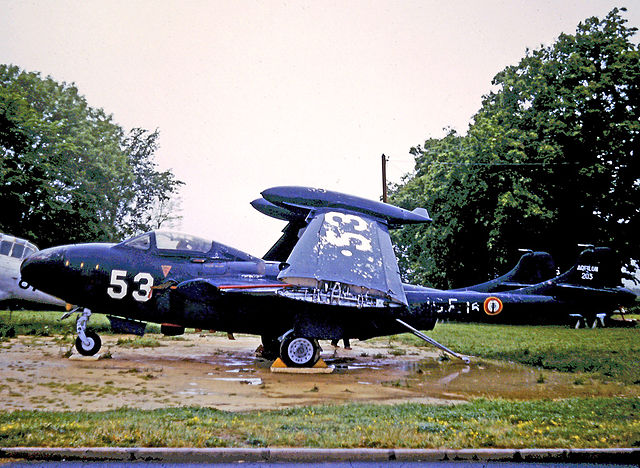
Preserved at Lorient, Britanny
Nominally, she could carry 48 aircraft in 1945. However from 1945 this park varied widly and far less were in really carried between the hangar and flight deck.
Later in her career her real capacity was established to 24 aircraft or about 30 helicopters.
Before 1968 she carried the following models:
–Breguet Br-1050 Alizé Turboprop ASW equivalent to the gannet, service 1959 to 1990, 89 built.
–Vought F4U-7 Corsair No need of an introduction.
–Grumman F6F-5 Hellcat France was one of the last users of the type.
–Fouga CM-175 Zéphyr: A tiny jet two-seat trainer in its marine version. 32 made, joined the board 1959.
–Curtiss SB2C-5 Helldiver: France operated these until the end of the Indochina war.
–Douglas SBD-5 Dauntless: Acquired by early 1945 to renew the Aeronavale park, retired 1954.
–SNCASE Aquilon A licenced version of the de Havilland Venom. First and only jet fighter aboard the carrier.
–Supermarine Seafire Mk III and XV only. Used over Indochina and retired 1955.
–Grumman TBM Avenger Used for torpedo/ground attacks and later ASW patrols before the Alize.
The hangar alone could accomodate thirteen TBM avenger, two Piasecky HUP-2 helicopters, or fifteen F4U Corsairs and two HUP-2.
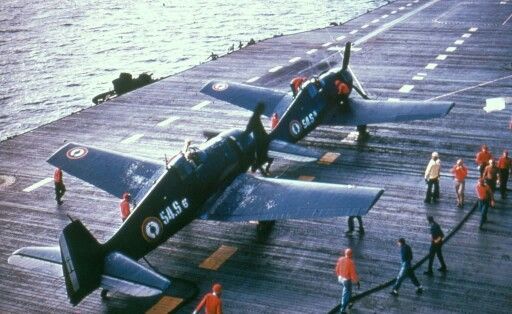
Hellcats on Arromanches in Indochina
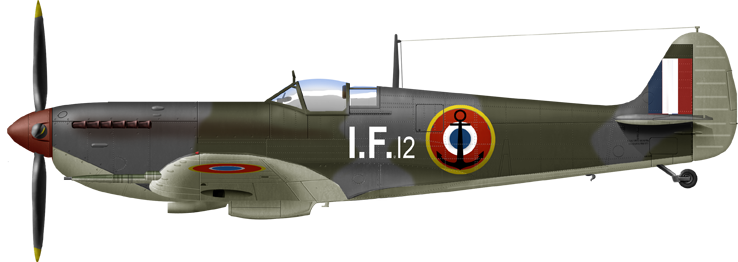
Seafire LIII Flotille 1F, Arromanches, Gulf Tonkin December 1948
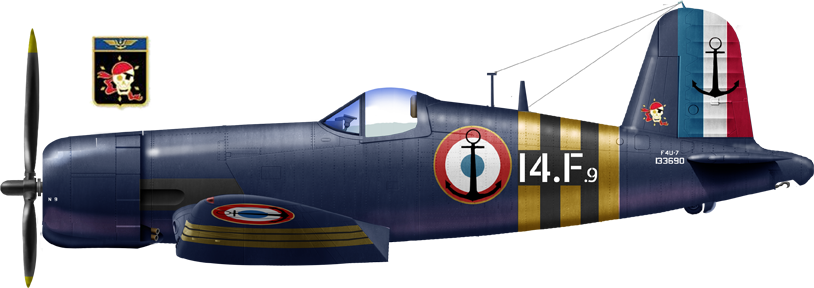
Vought F4U-7 “corsair” Flotille 14F, Op. Musketeer, FS Arromanches Suez 1956.
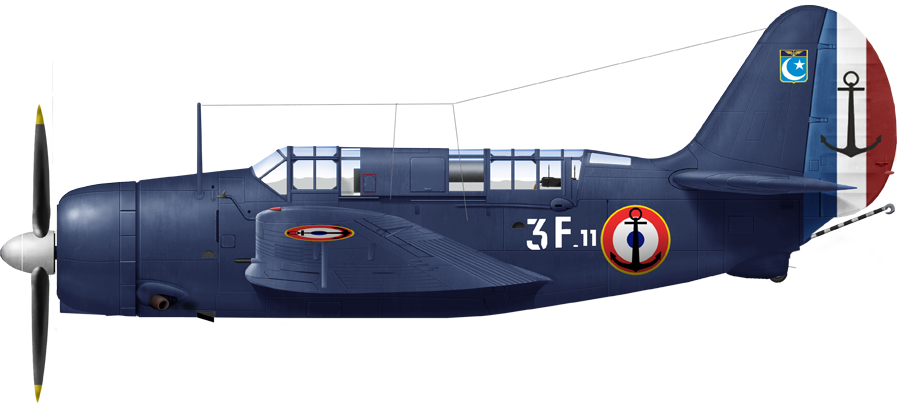
SB2C-5, FS Arromanches, Flotille 3F, French Indochina, Dien Bien Phu 1954
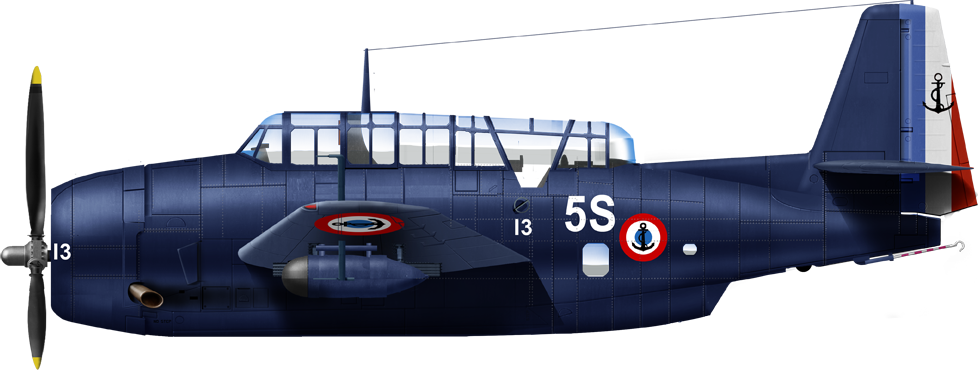
TBM-53 used for ASW patrol 4S Sqn. in 1958.
After her 1958 refit she lost her catapult but gained an angle deck and was reclassied as training carrier, preparing air crews for the Clemenceau class carriers.
Her airgroup at the time consisted of Alizé ASW and Zéphyr jet training planes only. The latter trained pilots to be later placed on the F-8 Crusader and Dassault Etendard cockpits.
Her last major transformation in 1968 made her an assault helicopter carrier but she kept her training role.
She was converted to a helicopter carrier with some 30 Alouette II/Alouette III, and/or Sikorsky S-51, Sikorsky S-55, Sikorsky S-58, Piasecki H-21, Piasecki H-25, plus three aircraft, the Morane-Saulnier MS-500 Criquet for recce, which was a STOVL based on WW2 Fieseler Storch.
⚙ specifications |
|
| Displacement | 14 000 t, 17 900 t FL |
| Dimensions | 693. 77 ft (length) x 118. 11 ft (width) or 211. 25 m x 36 m |
| Propulsion | 4 shaft Parsons turbines, 4 boilers 40 000 hp (29 840 kW) |
| Speed | 25 knots |
| Range | 12 000 nm @ 14 kts – 12 000 nm @ 14 kts |
| Armament | 24 x 2 pdr ‘Pom-Pom’, 14 x 40 mm bofors. |
| Protection | As Colossus, Belt, decks max 190 mm or 7.4 inches |
| Sensors | type 79B, type 281B, 6x type 282 radars, type 144 sonar |
| Air Group | 1950s: 13 TBMs, 2 HUP-2s or 15 F4Us and 2 HUP-2, 24 aicraft/30 helicopters |
| Crew | 703-844, see notes |
Career of FS Arromanches
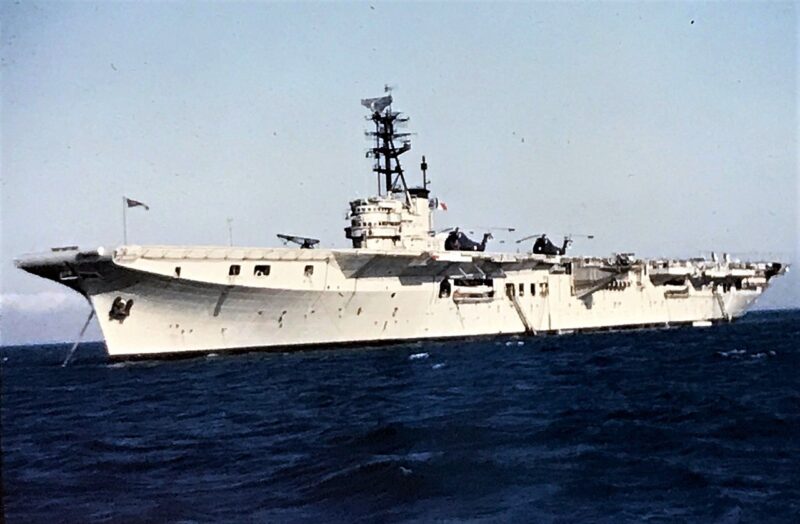
In short:
1951, Arromanches was officially purchased as the loan expired made two deployments to Indo China and two more deployments until 1954. Back in the Med she took part in Operation musketeer in 1956 on Suez. Modernized in 1957-58 with an angled deck and mirror, new radars, she became a training carrier, for future airmen of the first French Carriers of the Clemenceau class. In 1959 she had a new air group and from 1962 became an assault carrier with HSS-1 helicopters, confirmed after her last 1968 she was modernization as pure helicopter carrier/ASW escort/Fast transport/TS. She was withdrawn in 1974.
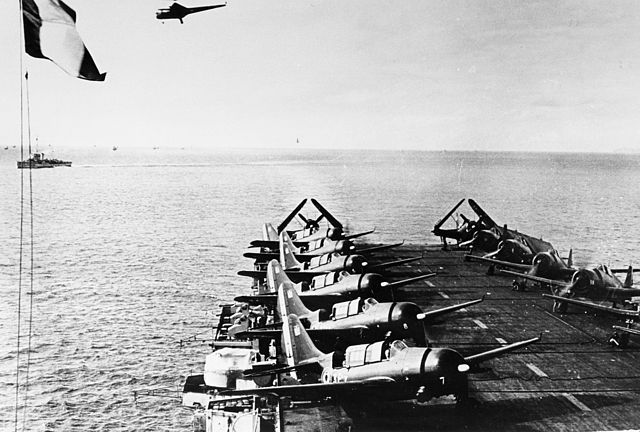
The flight deck of Arromanches off Indochina in 1951
Detailed chronology:
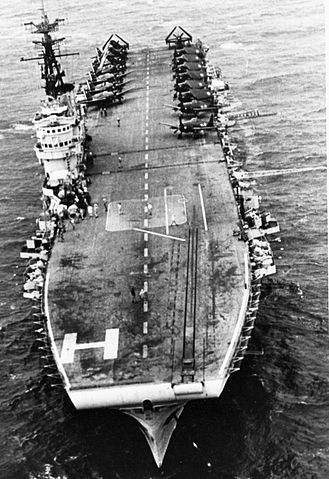 In 1945 after testing and training, Colossus is part of the Eastern Fleet and later British Pacific Fleet. In operations against Singapore and Kiushu and after the hostilities, returned back home, leased in 1946, August, to France for five years. In Cherbourg she is recommisioned after a ceremony on August 25, 1946 and renamed Arromanches. In 1947 she Cruised off North Africa, fleet training with the battleship Richelieu. The start of her Indochina campaign is 1948, with the 4F flotilla aboard still equipped with ten SBD Dauntless and two Supermarine Seafires as well as 8F Flotilla. She made a first three months deployments with six weeks of constant raids, 152 missions and 255 flight hours.
In 1945 after testing and training, Colossus is part of the Eastern Fleet and later British Pacific Fleet. In operations against Singapore and Kiushu and after the hostilities, returned back home, leased in 1946, August, to France for five years. In Cherbourg she is recommisioned after a ceremony on August 25, 1946 and renamed Arromanches. In 1947 she Cruised off North Africa, fleet training with the battleship Richelieu. The start of her Indochina campaign is 1948, with the 4F flotilla aboard still equipped with ten SBD Dauntless and two Supermarine Seafires as well as 8F Flotilla. She made a first three months deployments with six weeks of constant raids, 152 missions and 255 flight hours.
In 1949, February, 8 she sailed for home.
Indochina Campaign
In 1950 she had the first of her numerous maintenance refit, in drydock. Once done after some training she departs by late August 1951 to Indochina for her second of four campaigns, carrying the flotillas 1F freshly equipped with Grumman F6F Hellcat and and 3F flotilla with Curtiss SB2C Helldiver. Back home, she is Purchased from the Royal Navy and prepared for her new Indochina campaign, a long serie of raids on Vietminh communications routes, but also on-call close air support operations.
In June 1952 she is back home, to homeport Toulon. After R&R and some preparation she departs for a new campaign in Indochina by late August carrying flotillas 12F (F6F Hellcat) and 9F (SB2C Helldivers).
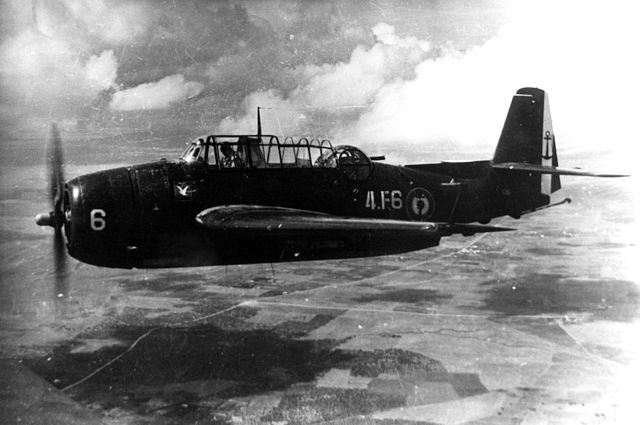
French TBM-3 of Flotille 4F, 1950.
In 1953, February she set sails for Toulon. After preparations and training she set sails agains for a last time to Indochina, on September 9, 1953, carrying Flotille 3F and 11F (F6F and SB2C) taking part from March to May 1954 in the dramatic and desperate siege battle of Ðiện Biên Phủ signalling the end of French presence in Indochina.
As peace talks commenced, she sails for home in September 1954. There, she has a major refit overhaul. She is then reassigned to the Mediterranean Fleet.
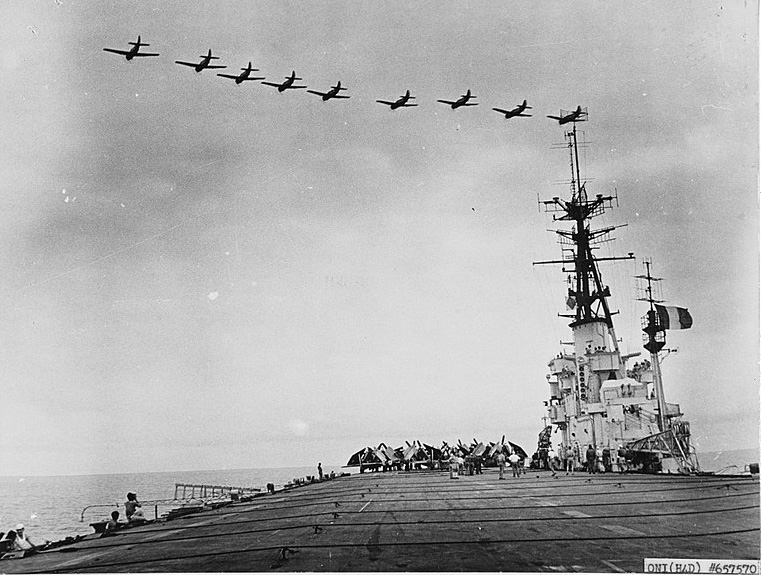
Gulf of Tonkin, November 1953
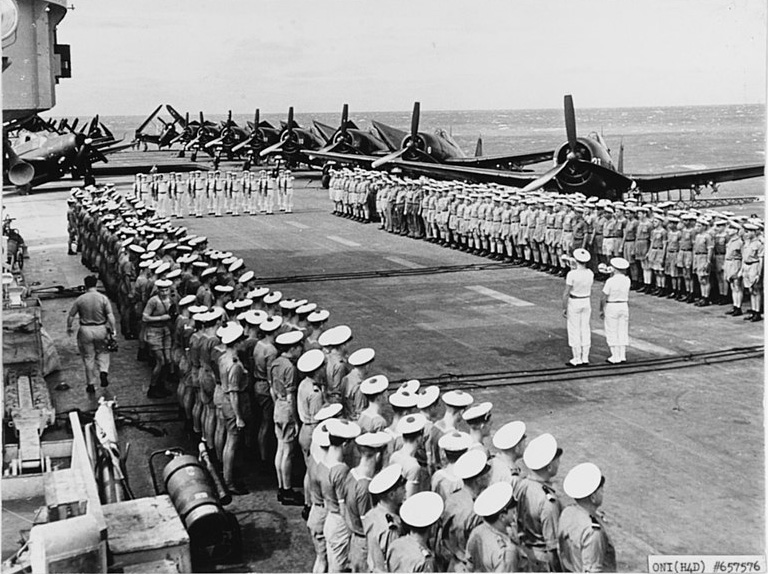
Gulf of Tonkin, 22 Jan 1954
Mediterrean Service: Suez and Bizerte
She trains with the fleet, making port calls all along the year 1955 and by October 1956 she is mobilized for Operation Musketeer (“Mousquetaire”) in company of La Fayette, and 14 F, 15F aboard, newly equipped with F-4U7 Corsairs and 9F Flotilla with ASW and attack Grumman TBF Avengers. Corsairs during the operation, receiving black-yellow id bands like the allied aviation from 1944, focused as planned on Cairo air base, while the Avengers are sent to sink the Egyptian fleet in Alexandria, but this was abandoned as too risky so close of US ships for the 6th Fleet. The operation would be pressured out by the US and USSR combined.
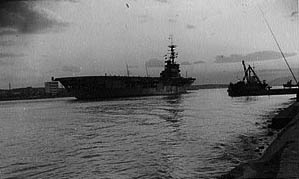 In 1957-58 the carrier underwent her major modernization (presumably in a British yard, information unknown), and she is fitted with a 4° angled deck offset to the axis in order to allow simultanous launches and recoveries or larger planes and jets, as well as the installation of the latest British carrier type landing mirror, and a new set of radars while the artillery is unloaded and reduced to the bare minimum to compensate and preserve stability. After this, she could operate jets and heavier turboprop models such as the Breguet Alize.
In 1957-58 the carrier underwent her major modernization (presumably in a British yard, information unknown), and she is fitted with a 4° angled deck offset to the axis in order to allow simultanous launches and recoveries or larger planes and jets, as well as the installation of the latest British carrier type landing mirror, and a new set of radars while the artillery is unloaded and reduced to the bare minimum to compensate and preserve stability. After this, she could operate jets and heavier turboprop models such as the Breguet Alize.
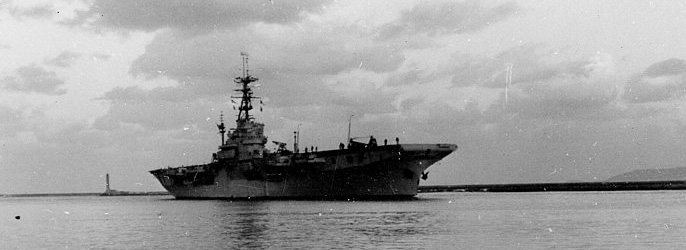
Off Bizerte, December 1957
1959 Training Aircraft Carrier
From 1959 she starts a new carrer as training aircraft carrier, training future naval aviation pilots aboard the Fouga CM-175 Zéphyr, the naval variant of the “jet glider” Fouga Magister. They are intended to form future air groups aboard the new French Aicraft Carrriers Foch and Clemenceau. For the first time she also operated the new ASW turbprop aircraft Breguet 1050 so to be able to double as specialized ASW carrier in wartime.
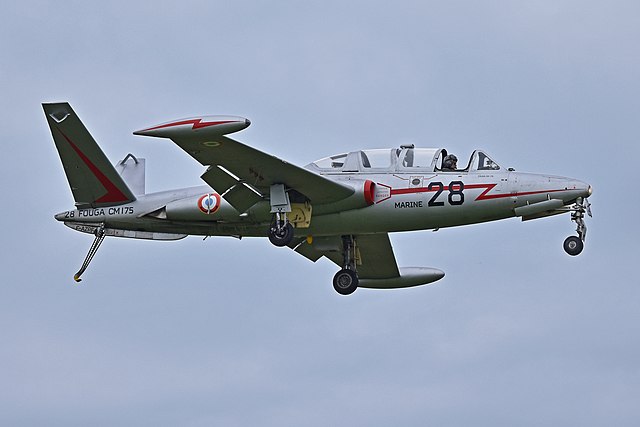
Fouga Zephyr
In 1961 she takes part in the French intervention during the Bizerte crisis. As a reminder, it happened by July 1961 when Tunisia imposed a blockade on the French naval base at Bizerte, hoping to force its evacuation. There was a three-day battle between French and Tunisian forces (630 Tunisians & 24 French dead) but France ceded the city and base in October 1963 under UN pressure and following the conclusion of the Algerian War. It should be noted that Arromanches never served in this war.
1961 Assault ship
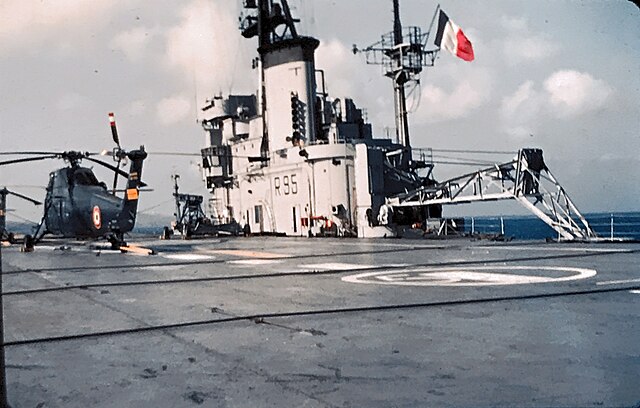
Arromanches in 1961
From 1962 she was refitted again as an operational rapid transport as well as an assault helicopter carrier and Commando carrier. For this she carried the newly formed 33F comprising Sikorsky HSS-1 helicopters, while she kept her training job, qualifying landings with the 59S squadron and flotilla 6F. Next she receioved her second helicopter unit, Flotille 31F with the same HSS-1 this time as a ASW unit, hoping to fouble in wartime as ASW carrier if needed. Training went on without anything notable until 1967.
From 1st September to 13 October 1967 she was mobilized for the Franco-Ivorian joint exercise “Alligator III” off the Ivory Coast, as part of the fleet, including the carrier Clemenceau and amphibious flotilla for landing exercises.
In 1968 she had a Major overhaul and new radars.
In May 19-22 1970 she takes part in the major landing exercise “Goéland” off Morbihan, Britanny, with Clemenceau and the amphibious flotilla.
She is decommissioned on September 5, 1974, the name is radiated and she takes the hull number Q525, placed in reserve until her sail on May 5, 1976.
By December 1977 she is sold to Alexandrian Frères Metal Company, Aubagne, southern France for scrapping, starting in 1978. There was an onboard naval postal agency which products are prized by collectioners.
Read More/Src
Books
Hobbs, David (2014). British Aircraft Carriers: Design, Development and Service Histories. Seaforth Publishing.
Wright, Christopher (September 2018). “Answer 20/55”. Warship International.
Les portes-avions Dixmude et Arromanches par Jean Moulin – Marines Editions – 1998 amazon.com, Marines eds.
Le porte-avions Arromanches par René Bail et Jean Moulin- Editions Lavauzelle 1983
Les portes-avions français des origines à nos jours par Francis Dousset- Editions de la Cité 1975
La Marine française dans la guerre d’Indochine par le CA (2S) Bernard Estival- Marines Editions- 1998
Monographie sur le porte-avions Arromanches edité par l’Association des Amis du Musée de la Marine- 1956
“Flottes de combat” books 1948-1972
“Sur les traces du Tigre” Vice-amiral Vercken Editions ARDHAN 1997
“Histoire succinte de l’Aéronautique navale” Vice-amiral Vercken ARDHAN 1998
“Commandements de l’Aéronautique navale” Major Norbert Desgouttes ARDHAN 1994n 2000
Cols Bleus review: 5 articles
Links
navypedia.org/
netmarine.net/
maritimequest.com/
ffaa.net arromanches.htm
web.archive.org britains-smallwars.com suez Mousquestaire
http://fleetairarmarchive.net/ /COLOSSUS.html
archive.org/details
web.archive.org btinternet.com/ rn-cv2
frenchnavy.free.fr arromanches.htm
netmarine.net/ more photos
hazegray.org/
fr.wikipedia.org
en.wikipedia.org/ Arromanches
Videos
Model Kits
Main query on scalemates
Heller Arromanches Porte-Avions 1/600, 1/400, 1/1600 Model Kit
Flugzeugtrager “Arromanches” Modern Navy Series Bauzustand 1946 bis 1956 HP-Models 1:700
Porte-Avions Arromanches (1954 fit) L’Arsenal 1:700


 Latest Facebook Entry -
Latest Facebook Entry -  X(Tweeter) Naval Encyclopedia's deck archive
X(Tweeter) Naval Encyclopedia's deck archive Instagram (@navalencyc)
Instagram (@navalencyc)





 Austrian Navy
Austrian Navy French Navy
French Navy Royal Navy
Royal Navy Armada Espanola
Armada Espanola K.u.K. Kriegsmarine
K.u.K. Kriegsmarine Dansk Marine
Dansk Marine Nautiko Hellenon
Nautiko Hellenon Koninklije Marine 1870
Koninklije Marine 1870 Marinha do Brasil
Marinha do Brasil Osmanlı Donanması
Osmanlı Donanması Marina Do Peru
Marina Do Peru Marinha do Portugal
Marinha do Portugal Regia Marina 1870
Regia Marina 1870 Nihhon Kaigun 1870
Nihhon Kaigun 1870 Preußische Marine 1870
Preußische Marine 1870 Russkiy Flot 1870
Russkiy Flot 1870 Svenska marinen
Svenska marinen Søværnet
Søværnet Union Navy
Union Navy Confederate Navy
Confederate Navy Armada de Argentina
Armada de Argentina Imperial Chinese Navy
Imperial Chinese Navy Marinha do Portugal
Marinha do Portugal Mexico
Mexico Kaiserliche Marine
Kaiserliche Marine 1898 US Navy
1898 US Navy Russkiy Flot
Russkiy Flot French Naval Aviation
French Naval Aviation Russian Naval Aviation
Russian Naval Aviation Sovietskiy Flot
Sovietskiy Flot Royal Canadian Navy
Royal Canadian Navy Royal Australian Navy
Royal Australian Navy RNZN Fleet
RNZN Fleet Chinese Navy 1937
Chinese Navy 1937 Kriegsmarine
Kriegsmarine Chilean Navy
Chilean Navy Danish Navy
Danish Navy Finnish Navy
Finnish Navy Hellenic Navy
Hellenic Navy Polish Navy
Polish Navy Romanian Navy
Romanian Navy Turkish Navy
Turkish Navy Royal Yugoslav Navy
Royal Yugoslav Navy Royal Thai Navy
Royal Thai Navy Minor Navies
Minor Navies Albania
Albania Austria
Austria Belgium
Belgium Columbia
Columbia Costa Rica
Costa Rica Cuba
Cuba Czechoslovakia
Czechoslovakia Dominican Republic
Dominican Republic Haiti
Haiti Hungary
Hungary Honduras
Honduras Estonia
Estonia Iceland
Iceland Eire
Eire Equador
Equador Iran
Iran Iraq
Iraq Latvia
Latvia Liberia
Liberia Lithuania
Lithuania Mandchukuo
Mandchukuo Morocco
Morocco Nicaragua
Nicaragua Persia
Persia San Salvador
San Salvador Sarawak
Sarawak Uruguay
Uruguay Venezuela
Venezuela Zanzibar
Zanzibar Warsaw Pact Navies
Warsaw Pact Navies Bulgaria
Bulgaria Hungary
Hungary

 Bundesmarine
Bundesmarine Dutch Navy
Dutch Navy Hellenic Navy
Hellenic Navy Marina Militare
Marina Militare Taiwanese Navy
Taiwanese Navy Chinese Navy
Chinese Navy Indian Navy
Indian Navy Indonesian Navy
Indonesian Navy JMSDF
JMSDF North Korean Navy
North Korean Navy Philippines Navy
Philippines Navy ROKN
ROKN IDF Navy
IDF Navy Royal New Zealand Navy
Royal New Zealand Navy Egyptian Navy
Egyptian Navy South African Navy
South African Navy

































 RN
RN
 Marine Nationale
Marine Nationale
 Soviet Navy
Soviet Navy
 dbodesign
dbodesign